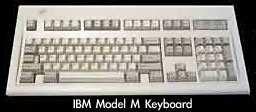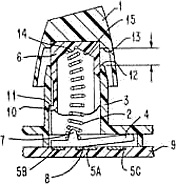Best Tools forthe Job
IBM Model M: The Best Computer Keyboard Ever
- 2007.01.15 -Tip Jar
It seems that Low End Mac has taken on something of a keyboardobsession in the last year or so. It started with a few articlesabout the Matias Tactile Pro keyboard (Has 'the Best Keyboard Apple Ever Made' BeenResurrected?), then moved to afew articles looking back at older keyboards, notably theApple Extended, Extended II, and the Northgate OmniKey.
My laptop articles have often focused on the relative meritsand/or weaknesses of laptop keyboards, including the good (MacBook,PowerBook, ThinkPad), the horrible (Dell), and everything inbetween. The one constant, however, is that the keyboard is thepart of your computer that you touch the most, and, strangely, it'sthe part that most buyers pay the least amount of attention to.
It's not a matter of Mac vs. PC or how many function keys youwant, but of build quality and switch type. There are many types ofkeyboard mechanisms, but all keyboards sold in the last 20 or soyears use either an Alps Switch, a buckling spring, scissor, orsoft dome to get their feel, along with a membrane switch toregister the keypress.
Clearly the most important thing that any keyboard does isregisters the letters that you type, but how it feels in thatprocess can make the difference between fast and accurate typingand slow and sloppy gibberish generation.
After reading Charles W. Moore'scolumns for years, I know that he prefers keyboards with a softtouch. In his case, it's due to a medical condition, although hemay very well have subjective reasons for that preference aswell.
I prefer a heavy, clicky keyboard. Clearly, Mr. Moore and Iprobably won't find happiness typing on the same keyboard, thoughstrangely two models are on both of our lists of the best keyboardsever made: the WallStreetPowerBook and the PowerBook1400.
I like those two keyboards because of the precise mechanicalfeel and the distinct feel when the key bottoms. These are softkeyboards, but they're also made with high-quality scissormechanisms that are precise and have no slop.
Slop equals typographical errors, and typographical errors equalwasted time and effort. A soft keyboard also influences how thetypist's hands must rest (on or off the keys) and what sort ofresistance is felt when entering a keypress.
Most of us can adapt quite easily to a soft or firmkeyboard.
A ThinkPad's keyboard has a much longer key travel and muchhigher effort than the keys on a PowerBook 1400 or WallStreet. Thefeel is totally different, but it's also my absolute favoritelaptop keyboard ever, with the MacBook a close second (shorttravel, but firm action).
Firm action may hurt the fingers of some typists, but I find itreduces fatigue as I can rest my fingers on the next key that I'lltype rather than maintaining tension by holding my fingers abovethe keyboard.
The IBM Model M Keyboard
Which brings me to my favorite keyboard, one that has seenupwards of ten computers (both PC and Mac, sometimes both with aKVM switch), 21 years, and millions of words. It is the famousIBM Model Mkeyboard, in my case one of the earliest PS/2 models made inlate 1986.
 MyModel M wasn't pretty, with all sorts of dust inside and the keyscovered in crud, but it worked great and is still the fastest andmost accurate keyboard that I've ever used. Over the holidays Ifollowed the care and feeding advice over at clickykeyboards.com, and nowmy Model M looks shiny and new again.
MyModel M wasn't pretty, with all sorts of dust inside and the keyscovered in crud, but it worked great and is still the fastest andmost accurate keyboard that I've ever used. Over the holidays Ifollowed the care and feeding advice over at clickykeyboards.com, and nowmy Model M looks shiny and new again.
So happy was I that I went back to clickykeyboards and ordered abrand-new, unopened 1995 Model M to use at the office, replacing afairly new and quite nice Microsoft wireless keyboard.
With the Model M, I type faster than on other keyboards -much faster. My personal best on a laptop was 50 words perminute on my old 12" PowerBook. I'vehit about the same speed on my various ThinkPads, MacBooks, andToshibas, but the 12" PowerBook was, in my opinion, the fastestlaptop keyboard.
I just took a typing test using my old Model M and hit 64 wordsper minute - and I had fewer typos in the process. There's justsomething right about the design; I really can't describe it otherthan saying that my finger always presses hard enough and never toohard on a Model M - are two of the many reasons for typos on lesserkeyboards.
Of course you still have to hit the right key, but even thatseems easier on this most magical of keyboards. The new one I justbought cost almost $70 for something made well over a decade ago,and I consider it a bargain.
Buckling Springs
 Whatmakes the IBM Model M so good? It's all in the spring - bucklingsprings, to be precise. A buckling spring is a mechanism thatcarries tension until enough force is applied to "buckle" thespring, at which point it collapses and the key can travel down,producing an audible click when it does.
Whatmakes the IBM Model M so good? It's all in the spring - bucklingsprings, to be precise. A buckling spring is a mechanism thatcarries tension until enough force is applied to "buckle" thespring, at which point it collapses and the key can travel down,producing an audible click when it does.
What makes these keyboards so sound so distinctive (and so loud)is that the spring makes another distinct click when tension isrelease and the spring pops back into its original shape. Ineffect, you get two fairly loud clicks every time a key is pressed,making you sound twice as fast as you really are - not to mentionannoying anyone in a nearby cubicle.
So noisy are these that IBM had to offer a "quiet" model (nobuckling spring) for libraries and such.
Of course, while noisy and intrusive to your neighbors, there'sone very good reason why the buckling spring keyboard remained inproduction for so many years and why it's something of a specialtyitem today. Those switches are very expensive compared to the cheaprubber domes in use today, and it's those switches that give thiskeyboard its legendary feel (and make it too expensive for this ageof made-in-China mass-production).
A Modern Model M with USB
You can still buy a brand-new Model M, and not only unsold oldones like mine, but a brand-new current production model. Unicomp still makes new Model Ms,only they call it a customizer. This is your only option if youwant Windows keys (a huge convenience for use on a Mac) andnative USB support. IBM and later Lexmark Model M keyboards all endin either a PS/2 connector, which can be adapted to USB, or theeven older AT connector, which can also be adapted but is moredifficult to deal with. Many of the old keyboards also were madefor point-of-sale terminals and cannot, to my knowledge, be used ona modern computer of any platform.
Still, whether you get a new one from Unicomp or a used orunsold IBM, it's definitely worth the effort if you like a firmkeypress. Unicomp offers a wide variety of styles, includingcolored (including black) keyboards; keyboards with built-intrackballs, pointing sticks or both; and your choice of USB or PS/2and Windows keys or no Windows keys.
A plain black one with USB and Windows keys will be the best fitfor most Mac and PC users these days.
Other Great Keyboards
Are there other great keyboards out there? Clearly, theNorthgate and Apple 'boards mentioned in previous articles allappear worthy of consideration, and by the sound of it so does theMatias Tactile Pro.
I used to use an Apple Extended Keyboard II back in the day andremember it fondly. In fact, it was the only keyboard other than myold IBM Model M that I've ever hooked up to one of my desktopcomputers. I prefer the feel (but not the sound) of the Model M tothe Extended II, but both are clearly high quality keyboards withexcellent feel and very fast action.
It really is a sad thing to look at the keyboards that come withmost computers these days. Whether you buy the cheapest $200eMachines or the fanciest, highest spec Mac Pro, you're getting a plastic keyboardof dubious quality. Apple's keyboards are crumb magnets, and mostPC keyboards are so flimsy that they won't support the weight ofthose crumbs. An old Model M, Extended II, or OmniKey may be justwhat your Mac or PC needs.
One thing is certain: If you generate a lot of text, you owe ityourself to get a decent keyboard.
When I took a three day trip last month and had a writingproject due, I brought my Model M in my luggage. My current ToshibaPortegé has a comparatively good keyboard for a laptop -good enough that I've used it to generate copious prose - but giventhe choice, I'll take my 20-year-old IBM Model M any day of theweek. ![]()
Editor's note: I'm a huge fan of the discontinued Logitech Cordless EliteDuo, which is far better than any recent Apple keyboard and hasgreat drivers for OS X. I simply can't work with any Applekeyboard made in the past several years - they're just too mushy.dk
Andrew J Fishkin, Esq, is a laptop using attorney in Los Angeles, CA.
Today's Links
- Mac of the Day: PowerBook 190cs, introduced 1995.08.28. The last 680x0-based PowerBook could take a PowerPC upgrade.
- Support Low End Mac
Recent Content
About LEM Support Usage Privacy Contact
Follow Low End Mac on Twitter
Join Low End Mac on Facebook
Favorite Sites
MacSurfer
Cult of Mac
Shrine of Apple
MacInTouch
MyAppleMenu
InfoMac
The Mac Observer
Accelerate Your Mac
RetroMacCast
The Vintage Mac Museum
Deal Brothers
DealMac
Mac2Sell
Mac Driver Museum
JAG's House
System 6 Heaven
System 7 Today
the pickle's Low-End Mac FAQ
Affiliates
Amazon.com
The iTunes Store
PC Connection Express
Macgo Blu-ray Player
Parallels Desktop for Mac
eBay

